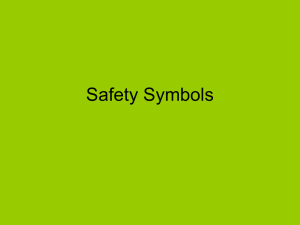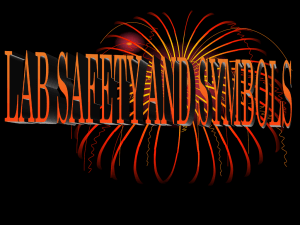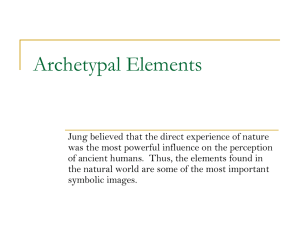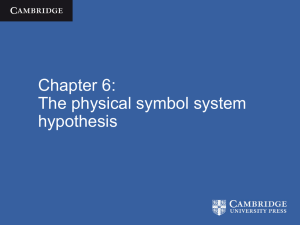Lab Safety Rules and Symbols
advertisement
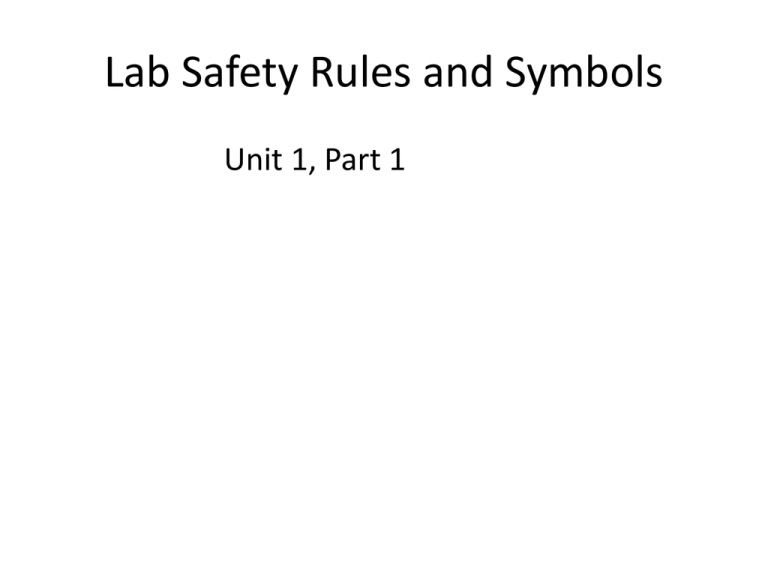
Lab Safety Rules and Symbols Unit 1, Part 1 Lab Safety • A few reminders when working in the lab: – No food or drink in the lab unless I specifically tell you otherwise. – Always read, re-read, re-re-read instructions, and be sure to ask questions before you get too far into an experiment. – Please be mindful of the fact that there will often be close to 30 people in the lab with you and that your safety and theirs is ALWAYS your first concern. – Familiarize yourself with lab equipment, safety symbols, and the location of first aid materials before beginning an experiment. Lab Safety Symbols: Glassware Safety • 1. Whenever you see this symbol, you will know that you are working with glassware that can easily be broken. • 2. Never heat glassware that is not thoroughly dry. Never pick up any glassware unless you are sure it is not hot. If it is hot, use heat-resistant gloves. • 3. Always clean glassware thoroughly before putting it away. Fire Safety • 1. Whenever you see this symbol, you will know that you are working with fire. Never use any source of fire without wearing safety goggles. • 2. Never heat anything unless instructed to do so. • 3. Never heat anything in a closed container. • 4. Never reach across a flame. • 5. Always use a clamp, tongs, or heat-resistant gloves to handle hot objects. • 6. Always maintain a clean work area, particularly when using a flame. Chemical Safety • 1. Whenever you see this symbol, you will know that you are working with chemicals that could be hazardous. • 2. Never smell any chemical directly from its container. Waft instead. • 3. Never mix chemicals unless instructed to do so. • 4. Never touch or taste any chemical unless instructed to do so. • 5. Keep all lids closed when chemicals are not in use. • 6. Immediately rinse off any chemicals that get on your skin or clothes. Then tell me! Heat Safety • 1. Whenever you see this symbol, you will know that you should put on heat-resistant gloves to avoid burning your hands. • 2. When heating a test tube or bottle, always point it away from you and others. Chemicals can splash or boil out of a heated test tube. Eye and Face Safety • 1. Whenever you see this symbol, you will know that you are performing an experiment in which you must take precautions to protect your eyes and face by wearing safety goggles. • 2. When you see this symbol, you should also make sure to pull your hair back away from your face for better vision and to keep from getting chemicals in it. Sharp Instrument Safety • 1. Whenever you see this symbol, you will know that you are working with a sharp instrument. • 2. Always use single-edged razors; double-edged razors are too dangerous. • 3. Handle any sharp instrument with extreme care. Never cut any material toward you; always cut away from you. • 4. Immediately notify me if you cut yourself. • 5. Know the location of the first aid kit! Electrical Safety • 1. Whenever you see this symbol, you will know that you are using electricity in the lab. • 2. Never use long extension cords to plug in an electrical device. Do not plug too many devices into one outlet. Make sure not to run cords across the sink. • 3. Never touch an electrical appliance or outlet with wet hands. Do not put anything in an outlet that should not be plugged in. Animal Safety • 1. Whenever you see this symbol, you will know that you are working with animals. • 2. Do not cause pain, discomfort, or injury to a live animal. Do not mutilate a dead animal. Do not make any unauthorized cuts on a dissection animal. • 3. Wash your hands thoroughly after handling animals or their cages. Review • • • • • What is the location of the fire extinguisher? What is the purpose of the red stop button? What is the location of the first aid kit? What color is the safety shower? What is the location of the fire blanket? • • • • • • What does this symbol mean? What should you keep in mind when you see it? What does this symbol mean? What should you keep in mind when you see it? What does this symbol mean? What should you keep in mind when you see it? • • • • • • What does this symbol mean? What should you keep in mind when you see it? What does this symbol mean? What should you keep in mind when you see it? What does this symbol mean? What should you keep in mind when you see it? • • • • • • What does this symbol mean? What should you keep in mind when you see it? What does this symbol mean? What should you keep in mind when you see it? Should you ever eat or drink in the lab? When should you read the lab directions? Measurement in Science Unit 1, Part 2 Units of Measurement • Since mathematics is the language of science (just as poetry is the language of love), and mathematical models rely on accurate measurements, it’s important that we’re all speaking the same language. Why? • Scientists (and you) use the international system of measurements, or SI, for labeling observations, calculations, and measurements. Consistency in Measurements • When all scientists (and you) use the same units for measuring data, sharing data and results is easier. • The SI is based on the metric system, and it uses seven SI base units, some of which are listed in the following table. SI Base Units Quantity Unit Abbreviation Tool Used Length Meter m Metric ruler Mass Gram g 3-beam balance Temperature Kelvin K C thermometer Time Second s clock Volume Liter L g.c.or ruler Current Amp A N/A Amount Mole Mol N/A SI Prefixes • The previous table listed the base units for the more common metric measurements. • However, the next tables will list some prefixes used for very small measurements and very large measurements. Prefixes for Large Measurements Prefix Symbol Meaning Deka dk or da Ten Multiple of Base Unit 10 Hecto h Hundred 100 Kilo k Thousand 1000 Mega M Million 1000000 Giga G Billion 1000000000 Prefixes for Small Measurements Prefix Symbol Meaning Deci- d tenth Multiple of Base Unit 0.1 Centi- c hundredth 0.01 Milli- m thousandth 0.001 Micro- millionth 0.000001 Nano- n billionth 0.000000001 Easy Mnemonic • • • • • • • KING (kilo) HECTOR (hecto) DIED (deka) UNEXPECTEDLY (unit) drinking (deci) chocolate (centi) milk (milli) Dimensional Analysis: Conversions • If you are converting a larger unit to a smaller unit, multiply the measurement to get a bigger number. To write 1.85 m as cm, multiply by 100 to get 185 cm. • If you are converting a smaller unit to a larger unit, divide the measurement to get a smaller number. To write 185 cm as m, divide by 100 to get 1.85 m. Practice Problems • Write 550 mm as m. • Write 3.5 s as ms. • Convert 1.6 kg to g. Parts of the Microscope • A compound microscope is made up of several parts. Some you should be familiar with are: • Stage - where the slide sits • Iris - adjusts the amount of light allowed in • Fine adjustment knob - focuses image • Coarse adjustment knob - moves stage • Eyepiece - what you look through • Objective lenses (low, medium, high) - three lenses with different magnification • Mirror or lamp - light source Microscope Calculations • Resolving power - the ability of a lens to distinguish between two objects (the higher the resolving power, the better able you are to see separate objects) or objects at different depths. • To calculate total magnification: multiply the eyepiece magnification (which is always 10) by the lens you’re looking through (usually 4, 10 or 40). That gives you a total magnification of 40 on low power, 100 on medium power, or 400 on high power. Methods of Science Unit 1, Part 3 Theories and Laws • A scientific theory is a hypothesis that has been supported many times and stands the test of time, but can change as new information is gathered (example: the theory of evolution). • A scientific law is a statement about events that always occur in nature (example: an apple will fall down from a tree, not fly up from it - the law of gravity). • Science can’t explain or prove all! Methods of Science Science as a process: Science is a process that produces a body of knowledge about nature. Applied Science: Science is used to apply general knowledge to real problems, or technology. The Scientific Method • In the scientific method, critical thinking is used to solve scientific problems. • What is critical thinking? The ability and willingness to assess claims critically and to make judgments on the basis of objective and supported reasons. • The scientific method is a great way to help you organize your thinking about questions that might be considered scientific. Step One:State the Problem • Most of learning happens by asking questions. Why is the sky blue? How does popcorn pop? What time is it when the sun is in mid-sky? • Your purpose or problem needs to be stated as a clear and specific question so you can answer it clearly and specifically. • Bad example: is fertilizer good for plants? • Good example: does adding fertilizer to plants make them grow taller? Step Two: Gather Information • The purpose for gathering information before beginning your experiment or developing a hypothesis is that it allows you to make informed, educated proposed solution. • This is best done in the library, as there are innumerable resources available. • It’s very important that you check for accuracy in your sources, and that you use a variety of media, such as book, magazines, professional journals, and internet. Step Three: Form A Hypothesis • A hypothesis is not an “educated guess”, but an informed, well-researched proposed solution. • It should be written in “if…then” format. • For example, “If fertilizer is added to a plant, then it will grow taller.” • The “if” statement is your independent variable. (whether fertilizer is added) • The “then” statement is your dependent variable. (its effect on the plant’s height) Step Four: Design and Conduct Experiment • Set up procedures for experiment before beginning it. Always describe the experiment so that another person reading your plan could repeat it. • An experiment can be a survey, an observation, a test, or an actual lab test. • Remember, during this stage, it’s important to keep other variables constant and only change one at a time. (controlled experiment) Step Five: Collect, Organize, Analyze Data • During this stage, you will receive all sorts of information to make sense of. • In order to present it in an orderly manner, graphs, charts, and tables are useful. • Line graphs are best for showing continuous growth. • Bar graphs are best for comparing individual sets of data. • Pie charts are best for showing parts of a whole. More on Graphs • Every graph needs: – Title that includes both variables – X and Y axis labels – Key – Units of Measurement – Accurate drawing Step Six: Form A Conclusion • Your conclusion should answer the question presented in step one. • For example, adding fertilizer to plants made them grow taller. • This is also an opportunity to make suggestions about improving your experiment, how to get more accurate data, changing variables, and things that could have gone wrong with your experiment. Step Seven: Repeat! • In order to insure accuracy of your results, you must show that, if your experiment is repeated, one would get the same outcome.


